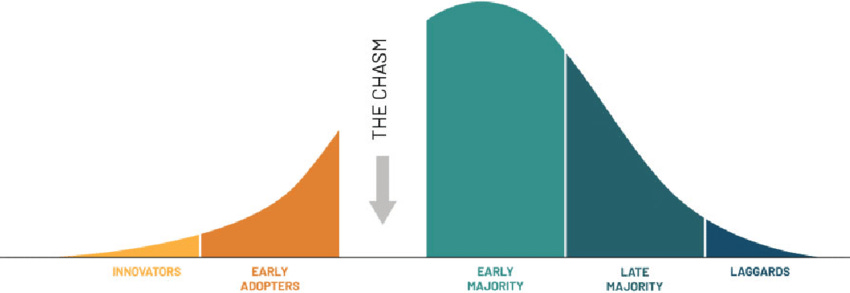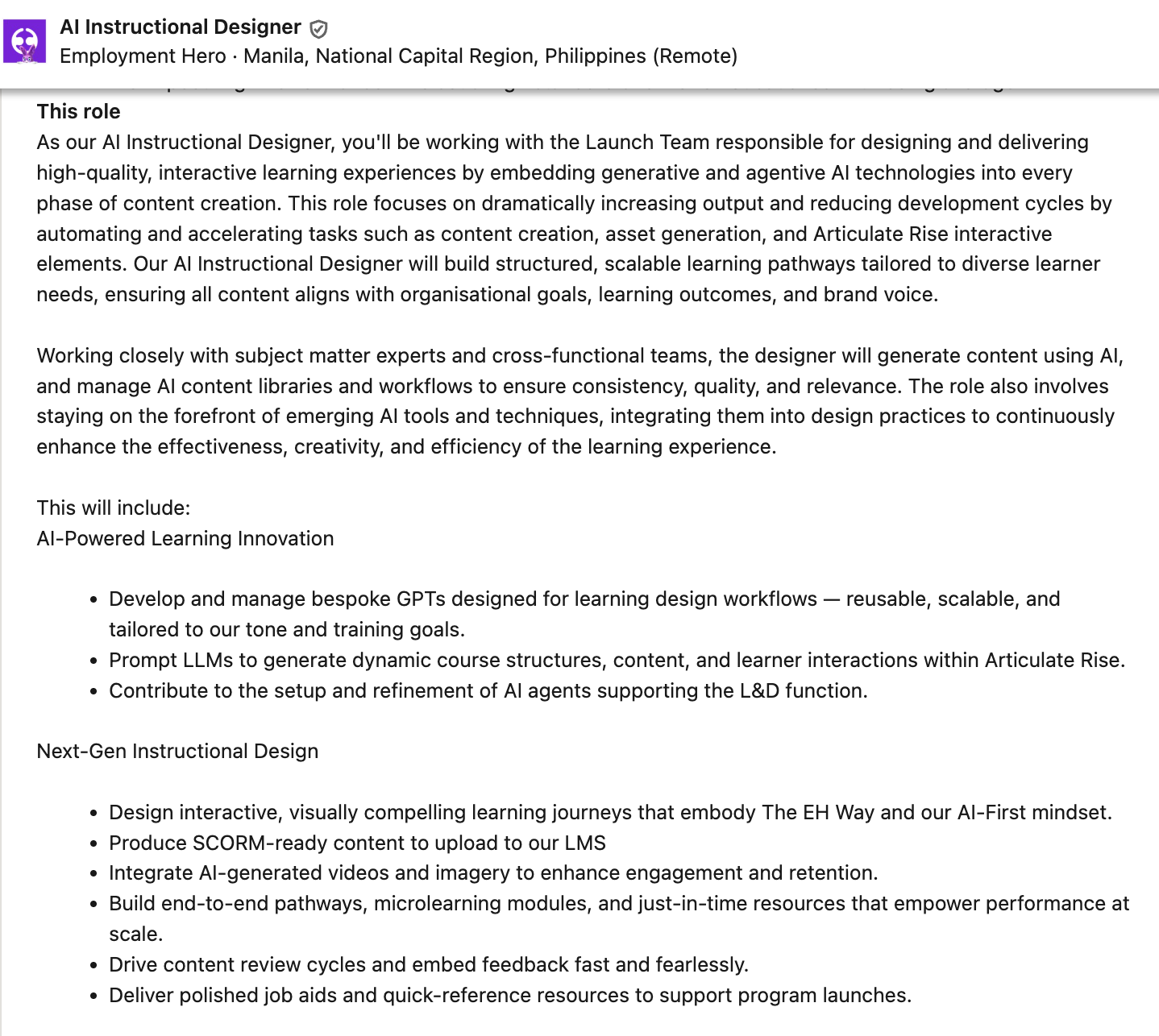GPT-Building, Agentic Workflow Design & Intelligent Content Curation
What 3 recent job ads reveal about the changing nature of Instructional Design
Hey folks!
Let’s start our journey this week by rewinding back to the 1970s. Imagine a world where Personal Computers (PCs) are widely used by most office workers, but at home or strictly on the sly. Fast forward ten years and the same PCs that were considered initially by businesses to be “toys for hobbyists” had demonstrated so much value and potential that they too significant for the market to ignore. By 1980, individual adoption had translated into a systematic change in how we work and how we define “office skills”.
A growing body of data on AI use in Instructional Design is starting to reveal a similar pattern. As my work with Synthesia showed, a whopping 84% of instructional designers report using generative AI tools on a weekly basis at the end of last year. Despite this, my own research suggest that only ~2% of current job ads explicitly mention AI competencies as a requirement for the Instructional Design role.
But in this paradox paradox sits some exciting promise. Why? Because established usage & adoption patterns - like those among PC users in the 1970s and 80s - show us that a disconnect between individual behaviours and market requirements is often a precursor to widespread and systematic change.
Given the rapid adoption of AI by individual Instructional Designers, a question I’ve been exploring recently is: are we close to (as Geoffrey Moore would say) “crossing the chasm” and entering a new professional paradigm in Instructional Design, complete with the reimagining of the role and skillset of the Instructional Designer?

In the last three months, I’ve become increasingly convinced that the answer is yes. Already, a new professional archetype has started to emerge which requires not just expertise in long-established authoring tools like Rise 360 but also advanced fluency with Large Language Models (LLMs) and skills in both generative and agentic AI.
In this week’s blog post, I’ll share my take on how the instructional design role is evolving and discuss what this means for our day-to-day work and the key skills it requires.
Let’s go! 🚀
Introducing “Pioneer Positions” in Instructional Design
As we’ve learned from other professions like coding and product management, the clearest sign that a professional transformation is underway is when early adoption turns into widespread practice and—ultimately—a reimagining of the toolkit and responsibilities that show up in job ads.
With this in mind, I’ve been keeping a close eye on open instructional design roles and, in the last 3 months, have noticed the emergence of a new flavour of instructional designer: the so-called “Generative AI Instructional Designer.”
Let’s deep dive into three explicitly AI-focused instructional design positions that have popped up in the last quarter. Each one illuminates a different aspect of how the role is changing—and together, they paint a picture of where our profession is likely heading.
PhoenixTeam’s "Generative AI Instructional Designer"
This role represents perhaps the most direct acknowledgment of AI's centrality to modern instructional practice. The position’s advertised salary range—$125,000–$175,000—signals the premium organisations are willing to pay for genuine AI fluency.
This isn’t just scarcity pricing. This compensation differential reflects recognition that AI-integrated design represents a qualitatively different knowledge and skill set. The role’s core responsibilities—creating hands-on AI workshops, building structured learning pathways for AI literacy, and translating complex generative AI concepts for diverse audiences—position the designer as both user and evangelist of AI-enhanced learning.
This position sits squarely at the intersection of instructional design, content strategy, and AI fluency. It requires not only experience with traditional tools and processes but also advanced proficiency in tools like ChatGPT, Claude, and Gemini.
It’s clear from the responsibilities—facilitating live AI workshops, designing microlearning paths, and creating enterprise enablement content—that the role demands both pedagogical depth and advanced AI fluency. The emphasis on prompt engineering, storytelling, and working across technical and business teams highlights a hybrid skill set that merges the responsibilities of the instructional designer with those of a subject matter expert (SME).
In short, this role isn’t just about the ability to use AI tools to automate the instructional design process—it’s a strategic and specialised role focused on driving a cultural shift toward AI adoption within a complex organisation.
Motorola Solutions' "AI Learning Experience Designer"
This role exemplifies the hybrid model emerging in many large corporations. It maintains a connection to traditional ID tools (Articulate Storyline, Rise 360) while explicitly requiring fluency with AI tools like NotebookLM for content summarisation and Gemini for general AI support in the flow of instructional design work.
Here, the instructional designer is positioned as an AI collaborator who is required to “provide expert oversight and refinement of AI-generated learning content.” Pushing beyond basic AI usage, this role also requires the (advanced) ability to build and maintain AI agents capable of supporting the learning process.
The Motorola position also asks instructional designers to “curate, tag, and organise learning content to improve discoverability and support AI-powered learning experiences”—a development and competency that points toward a fundamental reconceptualisation of content lifecycle management.
Traditional instructional design has long struggled with content reusability due to contextual specificity and format constraints (Wiley, 2000). AI agents, however, can potentially de-contextualise, restructure, and re-contextualise content across multiple formats and applications.
The Motorola role isn’t purely functional, however. The instructional designer is also expected to help define the organisation’s broader AI strategy and lead the creation of internal best practices for designing high-quality learning with AI.
Employment Hero’s "AI Instructional Designer"
We see a similar mix of beginner and more advanced functional AI knowledge and skills in the ad for an “AI Instructional Designer” at Employment Hero. The goal here is to embed both generative and agentic AI “into every phase of content creation.”
The instructional designer’s role is clear: “to dramatically increase output and reduce development cycles by automating and accelerating tasks such as content creation, asset generation, and Articulate Rise interactive elements.”
But this role isn’t just about efficiency—it’s also about building GPTs, managing AI content libraries, and maintaining agentic workflows. The instructional designer will also lead the testing and adoption of emerging AI technologies, optimising both the speed and quality of content creation and playing a key strategic role in driving an “AI First Mindset” across the organisation.
The Emerging Instructional Design Role & Skillset
Across all three pioneering roles, traditional authoring tools like Rise and Storyline are still required—but they’re now considered a “nice to have” baseline, rather than the must-have know-how of previous decades. What’s emerging is a new, hybrid skillset that blends traditional instructional design expertise with advanced AI fluency, systems thinking and strategic abilities.
AI isn’t just being used to do what we already do faster and cheaper—it’s also starting to usher in a new way of thinking about what we design and, with it, a new professional paradigm.
Here’s the TLDR:
Skill #1.Prompt Engineering
All three roles show that effective interaction with large language models (LLMs) is now a core skill. At PhoenixTeam, designers lead AI literacy workshops. Motorola emphasises oversight and refinement of AI-generated content. Employment Hero pushes further—requiring designers to prompt LLMs to generate entire course structures within Rise.
This is a shift from building content to building the systems which build learning experiences dynamically.
Skill #2.GPT Building
Employment Hero’s role introduces a more advanced expectation: developing bespoke GPTs tailored to brand tone and instructional needs. This marks a move away from out-of-the-box tools, toward building and refining your own AI collaborators.
Skill #3: Agent Building
Both Motorola and Employment Hero roles include designing and maintaining AI agents to support content development and real-time learning support.
Instructional designers here are expected to automate feedback loops, micro-support systems, and iterative learning experiences—again, this is essentially a shift from building “stuff” to building the strategies and systems which build learning experiences dynamically.
Skill #4: AI Tool Testing
Employment Hero places instructional designers at the forefront of AI tool evaluation—actively testing, adopting, and refining use cases. Motorola, too, emphasises the need for ongoing evaluation and best-practice development.
This is about moving beyond awareness to ownership of the tech stack.
Skill #5: Content Curation & Lifecycle Management
Motorola highlights the importance of tagging, organising, and preparing content for machine-readability and reuse. This signals a deep shift toward dynamic, AI-compatible content architecture—requiring metadata design, xAPI knowledge, and content ops thinking.
Skill #6: Strategic Leadership
Across all three roles, instructional designers are expected to shape organisational AI strategy, drive adoption, and evangelise best practices. These aren’t just content creators—they’re internal change agents guiding cultural transformation.
In short, instructional design is becoming more technical, more strategic and more agentic. The focus is shifting from designing discrete learning experiences to building intelligent, scalable learning systems.
While these may still be early adopter roles, they’re almost certainly a preview of what’s coming next. Designers who skill up in prompt engineering, agent building and AI strategy won’t just stay relevant—they’ll define the future of the field.
The “Now & Next” for the Instructional Design Role
Drawing parallels from other sectors like Software Development—where over 22% of new roles now require AI skills—we can expect rapid acceleration in the rise of the AI Instructional Designer. A conservative projection would be that 10% of roles will mention AI competencies within six months, scaling to ~25% within 12–18 months and becoming standard within 3 years.
So what will these roles look like, and how will they change our day to day work? Here’s my take, based on trends already underway:
Role Focus #1: LLM Fluency & Prompt Engineering Mastery – Designing reusable prompt libraries, few-shot chains, and fine-tuned GPTs that generate on-brand copy, quiz items, and coaching dialogues. Leading internal “AI literacy” workshops. This replaces heavy, linear storyboarding and SME-dictated copywriting once done in Word/PowerPoint before hand-coding slides. Authoring-tool wizardry is becoming baseline.
Role Focus #2: Agentic Workflow Design – Architecting, deploying, and monitoring AI agents that auto-draft content, push feedback to SMEs, surface performance support, and even triage help-desk questions. This replaces manual slide-level triggers, branching scenarios, and repetitive SCORM-packaging cycles.
Role Focus #3: AI-Driven Content Operations – Tagging, chunking, and curating assets for machine readability; managing metadata; running A/B tests on GenAI tools; creating governance checklists for bias, privacy and IP. This replaces static course uploads, opaque file structures, and months-long update cycles.
Role Focus #4: Strategic Leadership – Drafting organisational AI standards, advising on risk, and translating AI concepts for cross-functional stakeholders. Instructional Designers are increasingly becoming key players in the adoption of “AI First” startegies and helping to lead cultural transformation.
TLDR: what we define as the highest-value work of the instructional designer is shifting from hand-crafting content to engineering the systems and intelligence that generate and operate dynamic learning ecosystems.
Within this paradigm, the role of the Instructional Designer shifts from being primarily functional and specialised to being primarily strategic and deeply rooted within the operations and impact of the business.
Conclusion
If developments in the last three months—and patterns from other industries—tell us anything, it’s that AI isn’t eliminating traditional instructional design expertise. But it is reshuffling the value stack.
Once-valuable tasks like packaging, manual production, and LMS admin are now table stakes—or being delegated to AI. In their place, new differentiators like prompt design, agent building, AI governance, and strategic leadership are emerging—driving salary uplifts of 28–100% and blurring the line between instructional designer and subject matter expert.
This transformation is about more than adopting new tools—it requires a fundamental redefinition of the instructional designer's professional identity.
Designers who evolve into prompt engineers, agent builders, and strategic AI advisors will capture the new premium. Those who cling to traditional tool-centric roles may find themselves increasingly sidelined—or automated out of relevance.
Happy innovating!
Phil 👋
PS: Want to get ahead of the curve and develop cutting-edge AI skills & knowledge with me and a community of people like you? Apply for a place on my AI & Learning Design Bootcamp.




